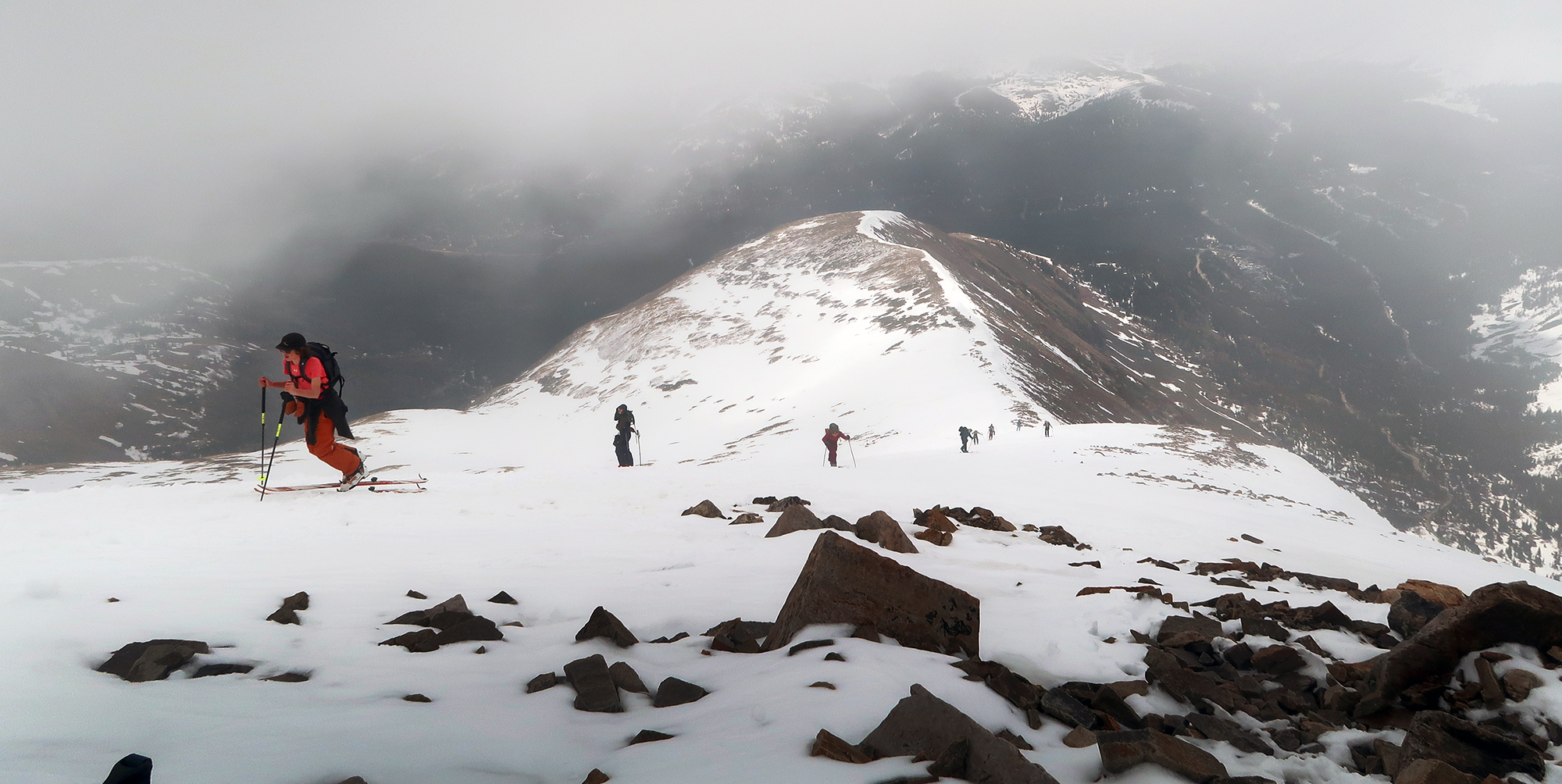May 23, 2023
A stormy spring
I met my friend at the trailhead for a springtime outing skinning/skiing Quandary Peak. From the looks of the parking lot area, a few fresh inches of snow had fallen the night prior. Even at Quandary’s lofty trailhead—roughly 11,000 feet above sea level—the snow looked wet. But with any luck, things would be a different matter near the 14,271′ summit.
That we were skiing one of Colorado’s tallest peaks in late May didn’t seem especially surprising. But that we could ski a majority of the peak under fairly excellent conditions was a bit unusual. From California to the Front Range, the mountain west had been blessed with above-average snowfall and a wet, cold spring. Colorado was hardly the biggest beneficiary. Alta, Utah had just set a new record for single-season snowfall. And Mammoth, CA announced they’d be skiing throughout July.
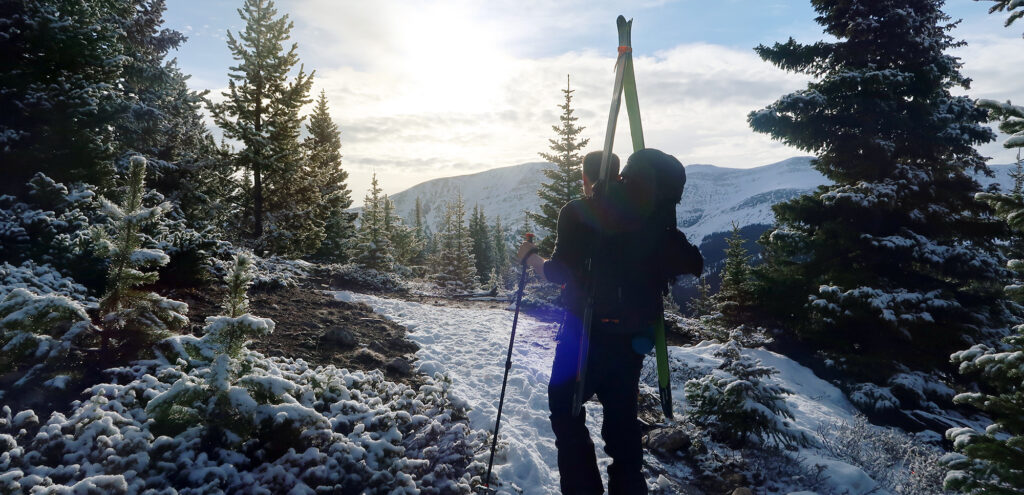
Colorado had an excellent year, but it was hardly a crazy outlier. Down the road from Quandary, Breckenridge resort would host skiers for their final weekend of the season. It marked a fairly typical closing timeframe, driven more by Vail Resort’s desire to balance the books than a lack of snow. But nearby Arapahoe Basin would also close in just another week or two. Colorado ski country was in transition.
We prepared our gear and walked across the dirt lot toward the trail. We saw plenty of other small groups of skiers and snowshoers. Someone on an online forum a day or two earlier claimed you could begin on skies from the car park. Sadly this was not the case. Our first ~800 vertical feet would happen on foot.
Skiing Quandary: an entry-level fourteener
Colorado hosts more than 50 peaks above 14K feet. In winter or summer, Quandary ranks among the easiest to scale. It’s a relatively gentle slope up its ridgeline. This means “class 1” hiking and a relatively low risk of avalanches in winter. At 3000 vertical feet, it’s also notably less strenuous/effortful compared to many other summits.
Of course, as a large sign early on along the hike announces: There is no such thing as an “easy” 14er. Ascending 3000 vertical feet to 14K is a major effort, and exposes you to ephemeral weather and all the standard risks of the alpine.
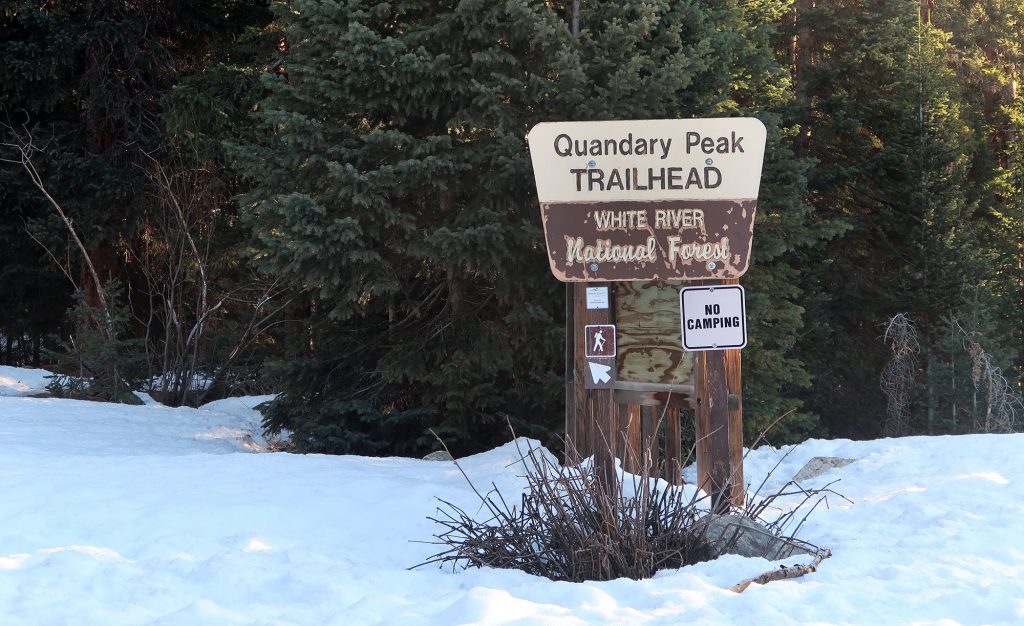
We were both a bit nervous and excited. While we each had a few days under our belt skinning in the backcountry (including beginner avalanche classes), neither one of us had tackled a fourteener on skis before. That said Quandary would be as appropriate a start as any peak.
May is a great time to avoid Quandary’s crowds
We began up the mountain around 6:30 am. The sun had already poked above the ridgeline to the east. The first third of the hike takes place below tree line, and this part felt quiet and peaceful. We rarely saw any other folks in the woods here.
Needless to say, this is a very different experience from summertime on Quandary. The peak ranks among the most hiked 14ers, along with Front Range summits like Bierstadt and Grays & Torreys. In addition to being among the easiest 14ers, Quandary is also among the most accessible. A paved roadway takes you right to the trailhead, about 30 minutes above the town of Breckenridge.

That said, visitation has dropped substantially in the past two years from its 2020 high. Some of this represents a ‘return to normal’ from the peak COVID outdoors boom. But the new shuttle and paid parking system probably also play an outsized role. Visitors arriving between late June and early September are required to visit hikeQuandary.com and secure either a parking or shuttle reservation. Parking on a summer Saturday costs an eye-popping $55 per vehicle.
On our trip, we saw perhaps 50 people in total that day. Snowshoeing or skiing Quandary early season provides an excellent way to avoid crowds. If you’ve never tried either before, I strongly recommend renting a pair of snowshoes and trying out a short hike. Nearby Breckenridge has an excellent Nordic center with groomed and marked trails. Snowshoes provide a low-impact way to efficiently traverse snowy slopes without “post-holing” every few steps. You may get hooked!
Pushing Higher
I think of Quandary’s standard ascent route as consisting of three segments. First, you travel along switchbacks through the woods to the treeline. This covers roughly the first 1000 vertical feet. Next, you travel along the ridge to a big “false summit” looming above you around 13K feet (the middle 1000 vert). Then, after traversing a flat, windy “saddle” area, comes a steeper push to the summit.
Around treeline, we donned our skis and began “skinning” up beyond the pines. This section can feel a bit monotonous. You’re on a uniform slope, staring at the same ridge crest for perhaps an hour. Decent conversation is key to helping things move along.
Skiing Quandary Bowl
We reached the flat windy area, and began up the final, steep “third” of the ascent. Looming ahead of us, to lookers’ right was “Quandary Bowl”. The bowl runs from roughly 14,000′ to 13,000′ with a northeastern aspect. The 10 Mile Range is hardly among Colorado’s biggest snow magnets. But this bowl has basically the perfect aspect and elevation for quality skiing.
Already we could see some early birds had made some beautiful turns through the bowl. The two-or-three inches of wet snow on the trees down low on the hill would become perhaps four-to-six wind-loaded inches of comparatively dry powder up here. The turns would feel glorious.

We pushed higher as clouds settled in around the peak. I was getting a little winded at this point. I hadn’t hiked this high in several months.
Quandary Bowl begins where the highest ski areas in the state end (around 13K feet). Nearby Breckenridge hosts North America’s highest chairlift, which dumps skiers at 12,800′. Our powdery turns in Quandary Bowl would end about 200 feet above that height.
Somewhere just shy of 14,000′ I suggested we transition to descent mode. My reasoning was two-fold. First, clouds were settling in and I wanted to see the bowl we were about to ski. Second, I was nervous all the more-fit climbers were about to rip up the snowfield before we had a chance to descend. My friend was a little bummed about not summitting. But ultimately he agreed to descend. Neither of us “needed” the summit anymore.
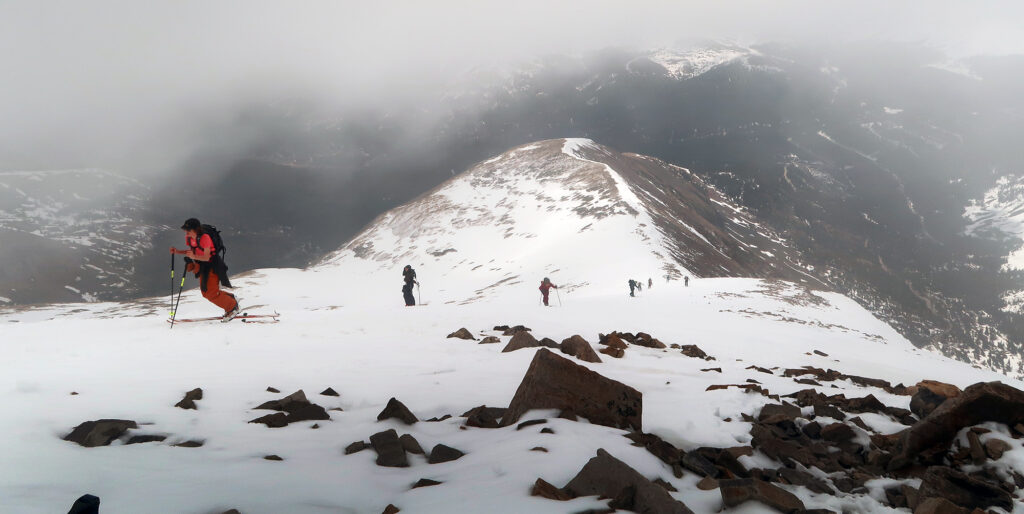
The descent
We pulled the skins off our skis, added a layer or two, and donned our helmets. I was giddy with excitement. Skiing down from such a high altitude was a rare treat. And we’d have a solid 2000 vertical feet of descent ahead of us.
Quandary’s ridge trail never exceeds 30 degrees in angle. This is the threshold beyond which avalanche risk rapidly rises. That said Quandary Bowl does feature bands of terrain beyond this threshold. Put simply: the bowl can slide. That said, we were not particularly worried that morning. The forecast for the region was “green” and had been that way for a few weeks. A couple of fresh inches didn’t change that. The snow beneath was firm and settled from the spring freeze-thaw. Nonetheless, we both brought the beacon/shovel/probe trifecta, just to be safe.
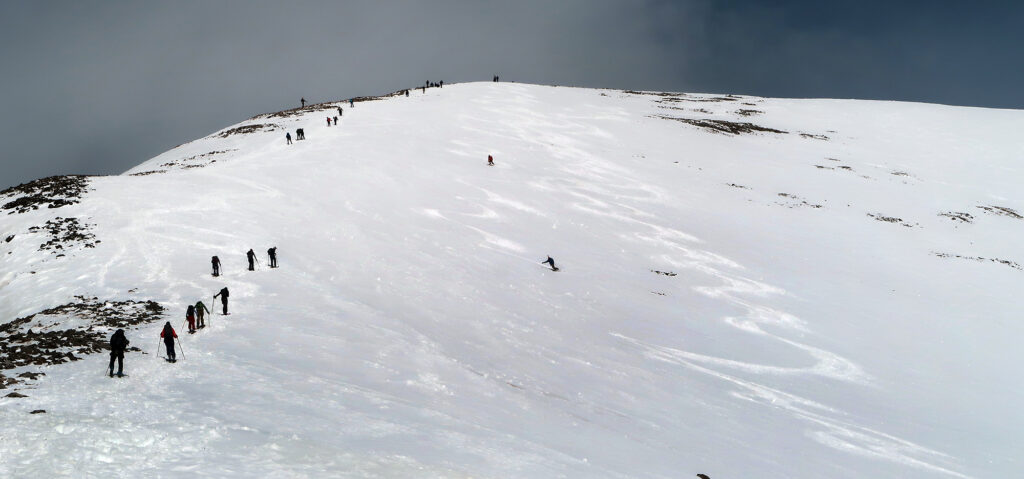
And just like that, we were skiing Quandary Bowl. I was pleasantly surprised at how soft and buttery the snow felt underfoot. We were perhaps the fifth and sixth set of tracks down the bowl that morning. There are other, more advanced/extreme routes down the peak. And some of the more-fit ascenders were surely descending those routes. Cristo Couloir comes to mind as among the most adrenaline-inducing. It’s no steeper than several on-resort runs I’ve skied (Highland Bowl and A-Basin’s East Wall both come to mind). But today was not about “boundary-pushing” so much as feeling things out.
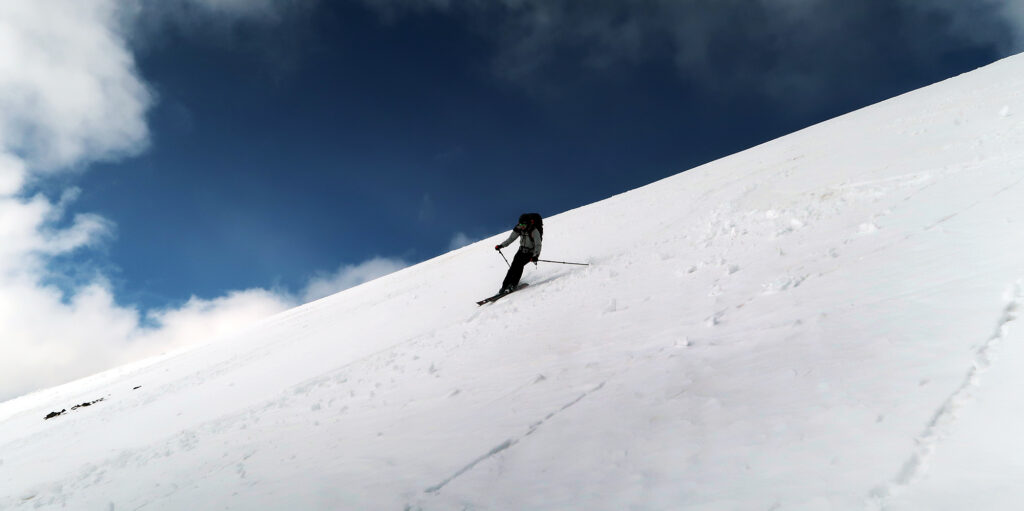
The lower descent
Quandary may rank among the easiest fourteeners, but plenty of search and rescue operations have transpired on this peak. For starters, it’s a very windy and exposed summit. And like all 14ers, you can lose visibility during bad weather. Stray too far from the main ridge and the terrain rapidly grows vastly more steep and unforgiving.
I bring all this up because, towards the bottom of Quandary Bowl, we had an important bit of navigation to take care of. We needed to stay high and to the right (skier’s right) to avoid entering steep terrain that would lead away from the standard trail. There were a lot of exposed rocks around here. And so, to keep things straightforward, I pulled up right back onto the ascent trail around 13,000 feet, and across its flat, corniced traverse.
But before long, we had reached the “middle third” of the descent. Here we drifted back to the left, and into the “lower quandary bowl” and steeper (and right now slushier) bowl that headed down towards treeline. The snow skied like corn in the sunshine of mid-morning. These were classic springtime turns.

Then, before the trees, we had a similar escape hatch to get right. We traverse hard skier’s right, and back towards the standard trail. I think a month earlier we could have descended into the trees here and just skied until we hit a road. But this late in the season, the snow would eventually turn into rotten patches between dirt and grass. Navigating towards the road in that morass would be a nightmare.
So instead, we hit the trail and skied as far as we could until it turned back into dirt. A short hike later we were back at the car park. It was time for lunch in Breckenridge. Our ski outing had been a success.

